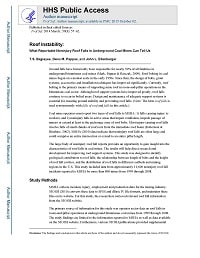Mining Publication: Roof Instability: What Reportable Noninjury Roof Falls in Underground Coal Mines Can Tell Us
Original creation date: March 2014
Authors: TS Bajpayee, DM Pappas, JL Ellenberger
Ground falls have historically been responsible for nearly 50% of all fatalities in underground bituminous coal mines (Mark, Pappas & Barczak, 2009). Roof bolting in coal mines began on a modest scale in the early 1950s. Since then, the design of bolts, grout systems, accessories and installation techniques has improved significantly. Currently, roof bolting is the primary means of supporting mine roof in room-and-pillar operations in the bituminous coal sector. Although roof support systems have improved greatly, roof falls continue to occur in bolted areas. Design and maintenance of adequate support systems is essential for ensuring ground stability and preventing roof falls. (Note: The term roof falls is used synonymously with falls of roof and falls in this article.)
Coal mine operators must report two types of roof falls to MSHA: 1) falls causing injury to workers; and 2) noninjury falls in active areas that impair ventilation, impede passage of miners or extend at least to the anchorage zone of roof bolts. Most injury-causing roof falls involve falls of small chunks of roof rock from the immediate roof beam (Robertson & Hinshaw, 2002). MSHA (2010) data indicate that noninjury roof falls are often large and could comprise an entire intersection or extend to an entire pillar length.
The large body of noninjury roof fall reports provides an opportunity to gain insight into the characteristics of roof falls in coal mines. The results will help direct research and development for improving roof support systems. This study was designed to identify geological contributors to roof falls, the relationship between length of bolts and the height of roof fall cavities, and the distribution of roof falls in different coalbeds and mining regions in the U.S. This study included data from approximately 11,600 noninjury roof fall incidents reported to MSHA by more than 800 mines from 1999 through 2008.

- Advance and Relieve Mining: A Method to Mitigate the Effects of High Horizontal Stress on the Mine Roof
- Application of Ground Penetrating Radar to Evaluate the Extent of Polyurethane Grout Infiltration for Mine Roof Control: A Case Study
- Diagnosing and Controlling Moisture-Sensitive Roof in Coal Mines
- Dynamic Failure in Deep Coal: Recent Trends and a Path Forward
- Make it Safer with Roof Screen
- Optimizing Secondary Roof Support with the NIOSH Support Technology Optimization Program (STOP)
- Overview of Coal Mine Ground Control Issues in the Illinois Basin
- Preventing Falls of Ground in Coal Mines With Exceptionally Low-Strength Roof: Two Case Studies
- Roof Screening: Best Practices and Roof Bolting Machines
- Technology News 483 - Safety Training Tools for Rock Scaling Personnel